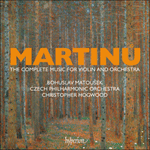
Welcome to Hyperion Records, a British classical label devoted to presenting high-quality recordings of music of all styles and from all periods from the twelfth century to the twenty-first.
Hyperion offers both CDs, and downloads in a number of formats. The site is also available in several languages.
Please use the dropdown buttons to set your preferred options, or use the checkbox to accept the defaults.

The premiere of Concerto da camera took place on 23 January 1942 in Basel with Gertrud Flügel and the Basel Chamber Orchestra under Paul Sacher. Three days later Sacher telegrammed to Martinů: ‘Violin concerto accepted with enthusiasm we all thank you.’ Because of the freshness of its musical invention, the sensual sound of the orchestral part and the virtuosity of the solo parts, the Concerto da camera is a favourite among Martinů’s instrumental concertos; it provides delight to both performers and listeners.
It was unknown until recently that Martinů later slightly simplified the solo violin part, probably as a result of suggestions from the American violinist Louis Kaufman, who describes it in his memoirs A Fiddler’s Tale. This version of the concerto was published by Universal Edition in Vienna, and is recorded here.
from notes by Aleš Březina © 2008
Le Concerto da camera fut créé le 23 janvier 1942 à Bâle avec Gertrud Flügel et l’Orchestre de chambre de Bâle placé sous la direction de Paul Sacher. Trois jours plus tard, ce dernier télégraphia à Martinů: «Concerto pour violon accueilli avec enthousiasme, vous remercions tous.» Par la fraîcheur de son invention musicale, par la sonorité sensuelle de sa partie orchestrale et la virtuosité de ses parties solo, le Concerto da camera est l’un des concertos instrumentaux les plus courus de Martinů, qui enchante les interprètes comme les auditeurs.
On sait depuis peu que, par la suite, Martinů simplifia légèrement la partie de violon solo, probablement sur les suggestions du violoniste américain Louis Kaufman, qui décrit l’œuvre dans ses mémoires A Fiddler’s Tale. C’est cette version allégée, publiée par Universal Edition à Vienne, qui est enregistrée ici.
extrait des notes rédigées par Aleš Březina © 2008
Français: Hypérion
Die Uraufführung des Concerto da camera fand am 23. Januar 1942 in Basel statt. Es spielten Gertrud Flügel und das Basler Kammerorchester unter Paul Sacher. Drei Tage später telegraphierte Sacher an Martinů: „Violinkonzert mit Begeisterung aufgenommen wir danken Dir alle.“ Aufgrund der Frische der musikalischen Einfälle, des sinnlichen Klangs der Orchesterstimmen und der Virtuosität der Solostimmen gehört das Concerto da camera zu Martinůs beliebtesten Konzerten. Es bereitet sowohl den Interpreten als auch den Hörern große Freude.
Bis vor kurzem wusste man nicht, dass Martinů die Soloviolinstimme später etwas vereinfachte, wahrscheinlich auf Anregung des amerikanischen Violinisten Louis Kaufman, der das in seinen Memoiren, A Fiddler’s Tale, beschrieb. Diese Fassung des Konzerts wurde bei Universal Edition in Wien veröffentlicht und hier eingespielt.
aus dem Begleittext von Aleš Březina © 2008
Deutsch: Elke Hockings
 Martinů: The complete music for violin and orchestra Martinů: The complete music for violin and orchestraA four-CD collection of this glorious music, now issued at super-budget price.» More |

